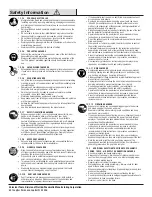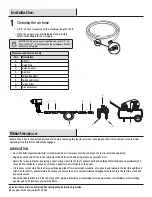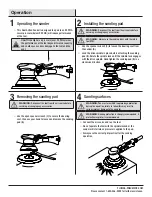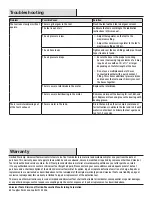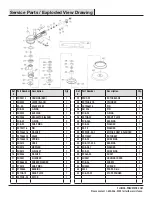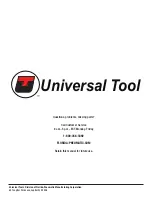
Universal Tool a Division of Florida-Pneumatic Manufacturing Corporation
851 Jupiter Park Lane, Jupiter FL 33458
7.2.2.3 GENERAL SAFETY RULES
• Multiple hazards. Read and understand the safety instructions before
installing, operating, repairing, maintaining, changing accessories on,
or working near the power tool. Failure to do so can result in serious
bodily injury.
• Only qualified and trained operators should install, adjust or use the
power tool.
• Do not modify this power tool. Modifications may reduce the effec
-
tiveness of safety measures and increase the risks to the operator.
• Do not discard the safety instructions – give them to the operator.
• Do not use a tool if the tool has been damaged.
• Warnings shall be given against the risk of explosion or fire due to the
material being processed;
• Warnings shall be given against the risk of cutting.
7.2.2.4 PROJECTILE HAZARDS
• Failure of the work piece, of accessories, or even of the tool itself may
generate high velocity projectiles.
• Always wear impact-resistant eye protection during operation of the
tool. The grade of protection required should be assessed for each
use.
7.2.2.5 ENTANGLEMENT HAZARDS
• Entanglement hazard - choking, scalping and/or lacerations can occur
if neck ware, hair or gloves are not kept away from tool and acces
-
sories.
7.2.2.6 OPERATING HAZARDS
• Use of the tool may expose the operator’s hands to hazards including
crushing, impacts, cuts and abrasions and heat. Wear suitable gloves
to protect hands.
• Operators and maintenance personnel must be physically able to
handle the bulk, weight and power of the tool.
• Hold the tool correctly: be ready to counteract normal or sudden
movements – have both hands available.
• Maintain a balanced body position and secure footing.
• Keep hands away from rotating or reciprocation accessories, spindles
or other moving parts.
• Release the start and stop device in the case of an interruption of the
energy supply
• Use only lubricants recommended by the manufacturer.
7.2.2.7 REPETITIVE MOTIONS HAZARDS
• When using a power tool, you may experience discomfort in your
hands, arms, shoulders, neck, or other parts of your body.
• While using a power tool, position your body in a comfortable
posture. Maintain secure footing and avoid awkward or off-balanced
postures. Changing your posture during extended tasks may help
avoid discomfort and fatigue.
• If you experience symptoms such as persistent or recurring discom
-
fort, pain, throbbing, aching, tingling, numbness, burning sensation,
or stiffness, do not ignore these warning signs. Promptly tell your
employer and consult a qualified health professional.
7.2.2.8 ACCESSORY HAZARDS
• Only use sizes and types of accessories and consumables that are
recommended by the power tool manufacturer.
7.2.2.9 WORKPLACE HAZARDS
• Slips, trips and falls are major causes of workplace injury. Be aware
of slippery surfaces caused by use of the tool and also of trip hazards
caused by the air line or hydraulic hose.
• Proceed with care in unfamiliar surroundings. Hidden hazards may
exist, such as electricity or other utility lines.
• This power tool is not intended for use in potentially explosive atmo
-
spheres and is not insulated from coming into contact with electric
power.
• Make sure there are no electrical cables, gas pipes etc. that could
cause a hazard if damaged by use of the tool.
7.2.2.10 DUST AND FUME HAZARDS
• Dust from some work processes can cause cancer, birth defects or
other respiratory diseases. Risk assessment of these hazards and
implementation of appropriate controls is essential.
• If the pneumatic tool is used in a dust filled environment exhaust
air can cause a dust hazard
• Dusts and fumes generated when using power tools can cause
ill health (for example: cancer, birth defects, asthma and/or der
-
matitis); risk assessment of these hazards and implementation of
appropriate controls of is essential.
• Risk assessment should include dust created by the use of the tool
and the potential for disturbing existing dust.
• Operate and maintain the power tool as recommended in these
instructions, to minimize dust or fume emissions
• Direct the exhaust so as to minimized disturbance of dust in a dust
filled environment
• Where dusts or fumes are created, the priority shall be to control
them at the point of emission.
• All integral features or accessories for the collection, extraction or
suppression of airborne dust or fumes should be correctly used
and maintained in accordance with the manufacturer’s instructions.
• Select, maintain and replace the consumable/inserted tool as
recommended in these instructions, to prevent an unnecessary
increase in dust or fumes
• Use respiratory protection as instructed by your employer or as
required by occupational health and safety regulations;
7.2.2.11 NOISE HAZARDS
• Unprotected exposure to high noise levels can cause permanent,
disabling, hearing loss and other problems such as tinnitus (ring
-
ing, buzzing, whistling or humming in the ears);
• Risk assessment of these hazards and implementation of appropri
-
ate controls of is essential.
• Appropriate controls to reduce the risk may include actions such as
damping materials to prevent work pieces from ‘ringing’
• Use hearing protection as instructed by your employer or as
required by occupational health and safety regulations;
• Operate and maintain the power tool as recommended in these
instructions, to prevent an unnecessary increase in noise levels;
• Select, maintain and replace the consumable/inserted tool as
recommended in these instructions, to prevent an unnecessary
increase in noise.
7.2.2.12 VIBRATION HAZARDS
• Exposure to vibration can cause disabling damage to the nerves
and blood supply of the hands and arms;
• Wear warm clothing when working in cold conditions and keep
your hands warm and dry;
• If you experience numbness, tingling, pain or whitening of the skin
in your fingers or hands, stop using the power tool, and tell your
employer. You should also seek medical advice from a qualified
occupational health professional.
• Operate and maintain the power tool as recommended in these
instructions, to prevent an unnecessary increase in vibration;
• Select, maintain and replace the consumable/inserted tool as
recommended in these instructions, to prevent an unnecessary
increase in vibration levels;
• Support the weight of the tool in a stand, tensioner or balancer,
because the operator can then use a lighter grip to support the tool.
• Hold the tool with a light but safe grip taking account of the
required hand reaction forces, because the risk from vibration is
generally greater when the grip force is higher.
7.2.3 ADDITIONAL SAFETY INSTRUCTIONS FOR PNEUMATIC
POWER TOOLS - AIR SUPPLY & CONNECTION HAZARDS
• Air under pressure can cause severe injury.
• Always shut off air supply, drain hose of air pressure and discon
-
nect tool from air supply when not in use, before changing acces
-
sories or when making repairs.
• Never direct air at yourself or anyone else.
• Whipping hoses can cause severe injury. Always check for dam
-
aged or loose hoses and fittings.
• Whenever universal twist couplings (claw couplings) are used, lock
pins must be installed.
• Do not exceed the maximum air pressure stated on the tool.
• Use whip check safety cables to safeguard against possible hose to
tool and hose to hose connection failure.
• Never carry an air tool by the hose.
Safety Information


